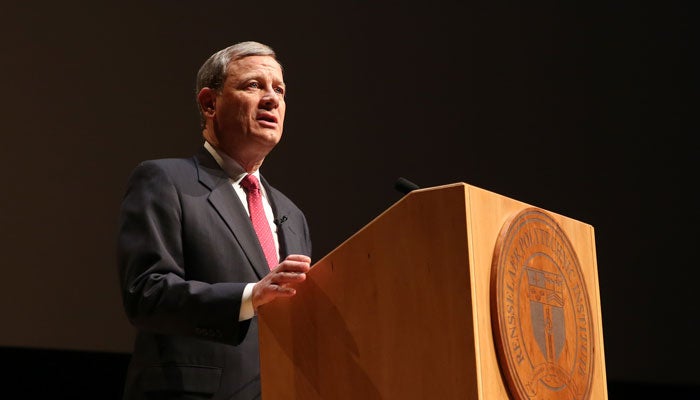Just one day after he confirmed Neil Gorsuch as the Supreme Court’s newest jurist, Chief Justice of the United States John G. Roberts Jr. visited the Rensselaer campus and held a lively discussion with President Shirley Ann Jackson in front of a packed house at the Curtis R. Priem Experimental Media and Performing Arts Center. During the day, Roberts made surprise visits to two classes—Introduction to Algorithms (taught by Mohammed Zaki) and Engineering Economics (taught by John Reilly)—and met with members of the campus at a reception following the talk.
“The new justice is not a Republican. He’s not a Democrat. He’s a member of the Supreme Court,” Roberts told an audience of approximately 900 Rensselaer students, faculty, and staff on April 11.
Before Chief Justice Roberts and President Jackson sat down for their wide-ranging conversation, he began by giving a history lesson. Roberts said he usually speaks at law schools, not STEM schools. He was invited to speak by President Jackson, who served as vice chair of the Smithsonian’s board of regents, which Roberts serves on because of his position as chief justice. For the talk at Rensselaer, he touched briefly on each of the previous 16 Supreme Court Justices and their connections (sometimes tenuous) to science. He said that his most significant connection to science “has been today’s talk!”
Roberts, a Buffalo, New York, native, received an A.B. from Harvard College in 1976 and a J.D. from Harvard Law School in 1979. He served as a law clerk for Judge Henry J. Friendly of the United States Court of Appeals for the Second Circuit from 1979–1980 and as a law clerk for then-Associate Justice William H. Rehnquist of the Supreme Court of the United States during the 1980 Term. He was Special Assistant to the Attorney General, U.S. Department of Justice, from 1981–1982, Associate Counsel to President Ronald Reagan, White House Counsel’s Office, from 1982–1986, and Principal Deputy Solicitor General, U.S. Department of Justice, from 1989–1993. From 1986–1989 and 1993–2003, he practiced law in Washington, D.C. He was appointed to the United States Court of Appeals for the District of Columbia Circuit in 2003. President George W. Bush nominated him as Chief Justice of the United States, and he took his seat September 29, 2005.
President Jackson began their conversation by saying that Rensselaer “must offer students breadth as well as depth in their education. So we’re pleased to present Chief Justice Roberts today.”
She asked which historical figure, or historical justice, has influenced him the most. “That’s an easy question to answer,” Roberts said. “John Marshall—he was the first person to take the job seriously. He appreciated the role of the court in bringing the United States together under the Constitution.”
Though it’s not a “political” branch of the government, President Jackson said the Supreme Court currently does operate in a “highly political environment,” especially in light of the nomination for the late Justice Antonin Scalia’s replacement. She asked how, or if, the politics of the confirmation process for nominees is different than in the past.
Roberts pointed out that “throughout this whole process, the Supreme Court has been quietly going about its business of deciding the cases before it according to the Constitution in a completely non-partisan way. We’ve done it for the past 14 months and will do it going into the future now that we have a full complement. It is a real danger that the partisan hostility that people see in the political branches will infect the non-partisan activity of the judicial branch.”
The hourlong conversation touched on technology in the courtroom (“A tremendous revolution,” according to Roberts), tension around race issues and how strict interpretations of a Constitution written so long ago can allow fair decisions, and lifetime appointments to the Court (Judges are not supposed to be popular, Roberts said. Lifetime appointments are vital).
President Jackson asked Roberts to offer students advice on “managing titans.”
“You have to have a light grip on the reins,” he said. Everyone is a leader in some sense—you must appreciate that others can sometimes lead more effectively. People bring different experiences to their jobs on the court, and that helps to fully inform the reading of the law, Roberts said.
“For every expert, there is an equal and opposite expert,” he said.
The event concluded with a Q&A session with the audience, and was followed by a brief reception with faculty, staff, and students.


